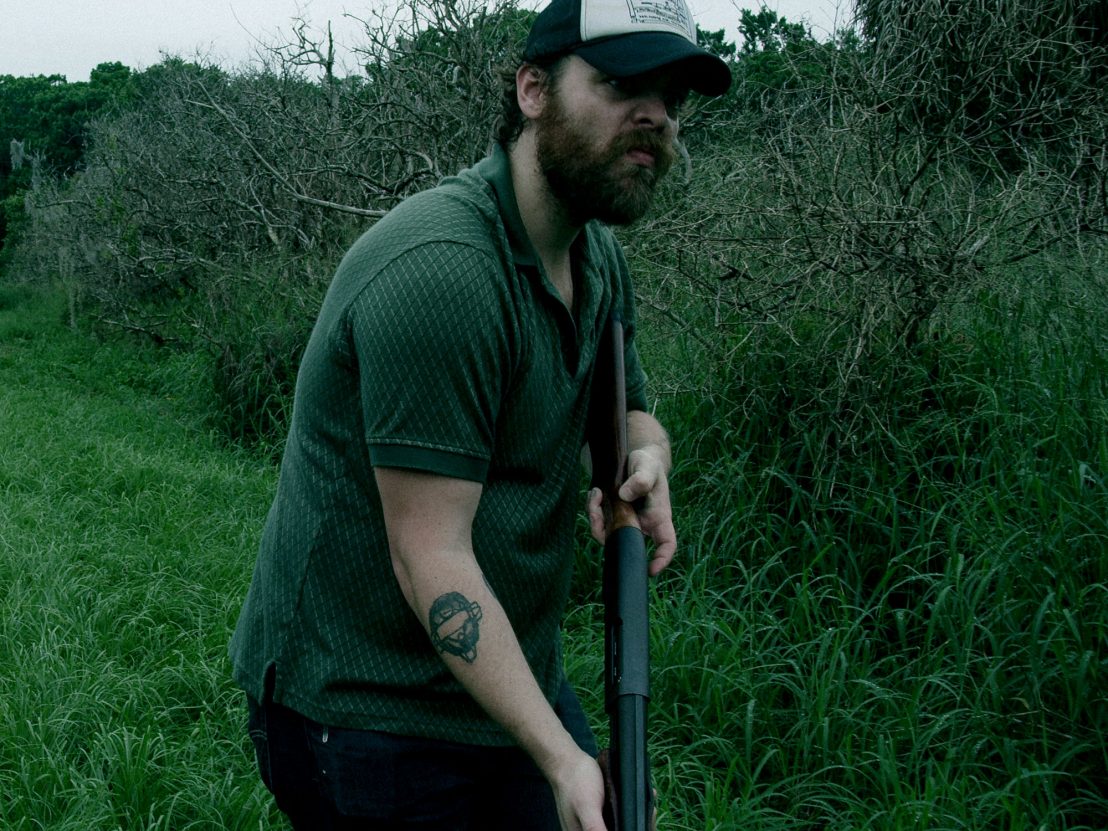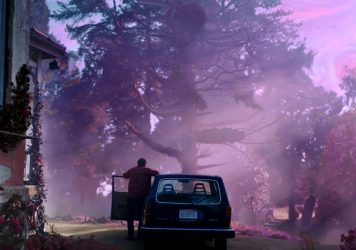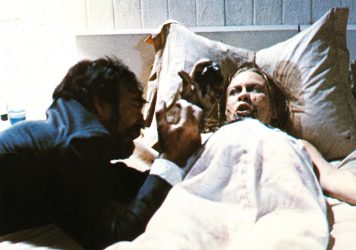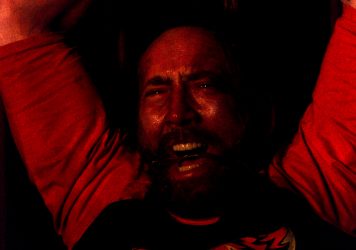
A wide shot shows a grassy grove with leafless trees on either side, as the soundtrack plays discordant synth tones and the sounds of a detuned radio. A woman in a dress, Abby (Brea Grant), staggers out in the distance, alone and alienated. “Hank?” she says. “Hello?”
In the opening to After Midnight, the scene is set for some classic backwoods terror. Hank (played by Jeremy Gardner, also the film’s writer and, with Christian Stella, co-director) leaps out suddenly – but then guides his girlfriend to the big old dilapidated house that has been in his family for generations, where they are to celebrate Abby’s birthday with some questionable wine, music and sex.
Even if Abby expressly refers to the place as “the Texas Chain Saw Massacre house”, and even if she asks Hank if his plan is to “just kill me or kill me and eat me afterwards,” his whispered reply as he nuzzles up behind her (“You’ve got it backwards: I’m going to eat you first”) suggests that After Midnight may be more concerned with romance then horror, even as it confounds the language of both.
Their sexual entanglement is interrupted by a violent cut to a scene, just short of 10 years later, where Hank is bearded and alone in the house at night, shooting through the front door at something growling outside – and so horror comes roaring back onto the agenda. In fact, After Midnight keeps switching between Hank’s decade-long relationship with Abby (shown in a series of flashbacks, always set during Abby’s birthdays), and his present-day isolation and beleaguerment by a strange creature that comes only late at night and tries aggressively to get inside.
Like the creature itself, the film is a peculiar hybrid, combining a couple’s love affair with monster mayhem, as we try to work out simultaneously to where (and why) exactly Abby has disappeared, and what the precise nature of Hank’s nocturnal assailant is.
It comes as little surprise that Aaron Moorhead and Justin Benson are attached to After Midnight as producers, and that Benson plays Abby’s sceptical policeman brother Shane. For Moorhead and Benson directed (and Benson wrote) that other great recent transmutation of horror and romance, 2014’s Spring, in which Gardner had a small role.
Gardner and Stella’s film first appeared on the festival circuit as Something Else, a title which alludes to the story’s lack of generic fixity, but the title After Midnight on which the filmmakers eventually settled for its release suggests that this might be an annex to Richard Linklater’s Before trilogy. After all, if Linklater’s films track the evolution of a couple’s relationship over many years, from lovey-dovey beginning through settling, malaise and crisis, After Midnight does exactly the same thing. And Gardner’s screenplay brings a nuance and subtlety to his characterisation of Hank and Abby that is seldom seen in a straight horror film.
Hank runs a bar in the rural Florida community of Barlow, but in his free time he likes to hunt. When the monster starts appearing at his door, Hank draws on his hunting skills for various attempts to stop it dead in its tracks – but Abby also imagines that Hank’s status as a hunter extends to his pursuit of other women. This confusion of the venatorial and the venereal is also evident in the big buck which Hank has recently killed, and whose horned head he can, now that disapproving Abby is gone, remove from its hiding place and mount on the house’s wall. For he has given to that dead buck the decidedly amatory name ‘Valentine’.
The presence of Valentine in certain key scenes, with its erotic sobriquet and phallic antlers, forges an associative link between the film’s twin status as love story and creature feature. In one extraordinary uncut, single-shot sequence, Amy tells Hank of her hopes, regrets, frustrations and disappointments in their relationship. It is a deeply personal scene, full of intimate and intense revelations. Significantly, however, it also takes place as both of them sit staring out the house’s open door into the night, waiting for the creature to come, a shot gun laid in readiness across Hank’s lap. Their emotional apocalypse, and the monster’s advent, always seem to be running parallel tracks.
The Latin monstrum from which ‘monster’ derives originally denoted a sign, omen or portent, and indeed much of After Midnight unfolds as a hunt for the meaning of its own featured creature. Shane thinks whatever has left its giant scratches in Hank’s front door must be a ‘black bear’, while Hank’s best friend Wade (Henry Zebrowski) wavers between it being a ‘panther’, or an irradiated mutation of Hank’s missing pet cat Darby, or an alien.
Hank himself variously wonders whether it is “a big bad wolf trying to blow our house down”, or perhaps Abby herself aggressively seeking a return after leaving Hank (“Are you some kind of shapeshifter, Abby? Like some kind of werewolf?”), while the recurrent lyrics of the song playing on the turntable (“this one’s in your head”) as Hank busies himself mounting Valentine’s head on the wall suggest the possibility that the monster is merely a figment of Hank’s fragile psyche, buffeted as it is by anger, loneliness and heartache.
On their very first date in the house, 10 years earlier, Abby had joked about the idea that Hank took girls there to hide their bodies in the attic, and we are left, in Abby’s current absence, to entertain the possibility that she may be murdered rather than missing, and that the monster may be her ghost, or a manifestation of Hank’s conscience, haunting him with guilt and regret for what he has done.
In other words, as Hank’s different anniversary memories fall into place, building a mosaic-like picture of a long-term, loving relationship and its gradual breakdown, and of a couple failing with the passing years to get married or to have children or to move on from their childhood town, the intrusive, ever-returning monster proves a multivalent symbol. For it literalises the destruction of Hank and Abby’s already crumbling home, while embodying the emotionally vulnerable Hank’s particular susceptibility at night to drunken episodes, despairing nightmares and mental collapse. Or maybe, far from being a shifting, polysemic metaphor, the monster is just a monster.
No matter, though, whether you read its creature as figured fantasy or toothy reality, After Midnight boasts a dream team in its two leads. Jeremy Gardner is also the director/star of The Battery and Tex Montana Will Survive!, and star of Psychopaths, Bliss and Fingers, while Brea Grant is the director of 12 Hour Shift, writer/star of Lucky and star of Beyond The Gates, Dead Night, Bad Apples.
In other words, Gardner and Grant are two of the most exciting talents working in American independent horror today – and when they bring their creative chemistry together, mixing in a lot of the heavy drinking and heavier karaoke so familiar from the indie genre scene, the result is a Frankenstein’s monster, insinuating fear while looking for love.
After Midnight is available on High Definition Blu-ray in a two-disc Special Edition that also includes Jermey Gardner’s feature debut The Battery, from Arrow Video on 8 June.
Published 8 Jun 2020

Nicolas Cage encounters an unholy cosmic terror in director Richard Stanley’s HP Lovecraft adaptation.

By Anton Bitel
Warner Bros took legal action over 1974’s Beyond the Door, but its differences from Friedkin’s film are more striking than its similarities.

Panos Cosmatos unleashes hell on Nicolas Cage and Andrea Riseborough in this bloody, psychedelic headtrip.